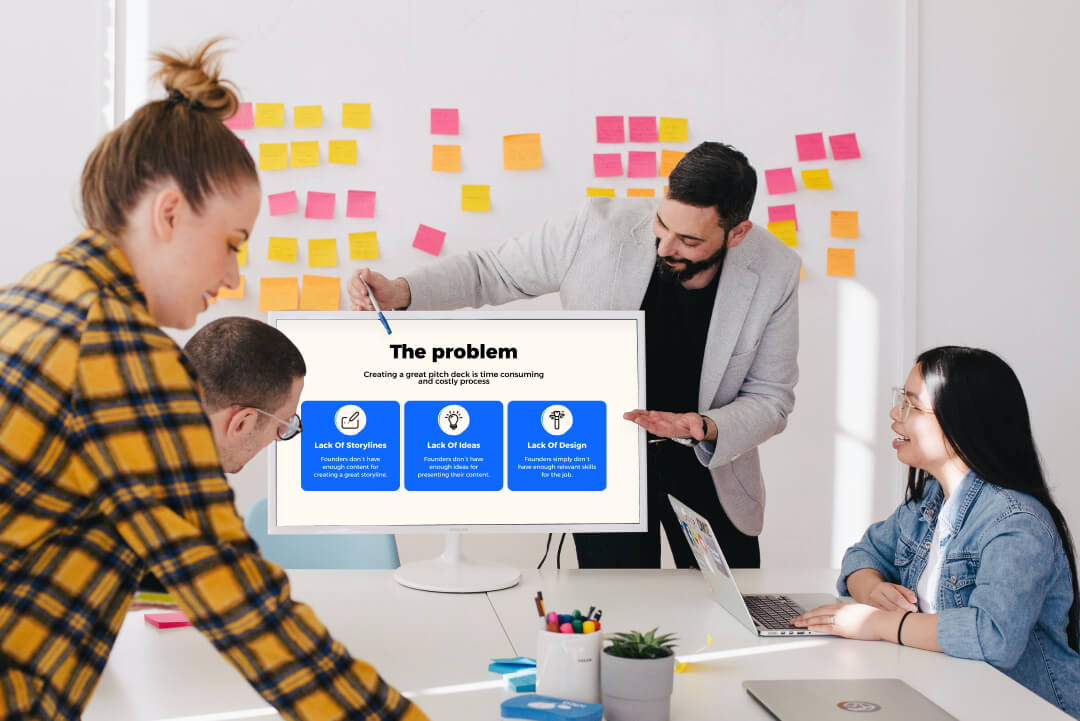
30 Best Startup Pitch Deck Examples [2025]

Over 90% of startups fail. Not a very inspiring thought, is it? What if we told you there is a possibility of standing out from the competition and making it to the funding stage with a reliable investor? A convincing pitch deck can help the viewers realize why your innovation matters.
Good pitch decks are more than just visually appealing introductions to your product. They are your perfect chance to outline your brand identity, present the team, discuss market opportunities, and describe a revolutionary solution to an existing problem. If you look at great pitch deck examples from successful startups, you’ll notice they all tell compelling stories that resonate with each person in the audience.
Professional presentation decks emphasize your unique strengths, financial projections, and potential for growth. These points, along with other factors, speak of potential income, and that’s what ignites investors’ interest. Many of the best pitch deck designs also achieve this by combining strategy with strong visuals and storytelling.
Eleanor Roosevelt once said, “Learn from the mistakes of others. You can’t live long enough to make them all yourself.”
Today, we’ll review the most successful pitch deck examples from different fields, including some from the tech industry and consumer goods field that secured multimillion-dollar funding, and point out major aspects to learn from.
Who knows where this virtual adventure may take you?
Best pitch deck examples from successful startups
Here is a list of 30 real-life examples of pitch decks that landed investments at one time or another. We’ll focus on the main points that helped these startups succeed. Among them, you’ll also find some truly creative pitch deck examples that stand out for their originality and approach. You can use these ideas to update your presentations and drive your chances of getting funding.
1. Airbnb
.jpeg)
Industry: Travel & Hospitality
Year: 2009
Stage: Seed
Funding Raised: $600K
Key takeaways:
Airbnb’s pitch deck is widely regarded as one of the most iconic early-stage presentations of all time — and for good reason. It set a new standard for how to communicate a big idea with clarity, confidence, and simplicity.
The deck stands out for its sharp focus: Every slide delivers a single, memorable message. Its minimalist aesthetic isn’t just about design but also reflects the clarity of thinking behind the business itself. What makes it powerful is how easy it is to understand. The problem feels real, the solution feels obvious, and the opportunity feels huge. Without overloading the viewer, it tells a story that feels inevitable — something every investor wants to believe in.
2. Pepper Bio

Industry: Biotechnology
Year: 2021
Stage: Seed
Funding Raised: $6.5M
Key takeaways:
Pepper Bio’s deck is a great example of how to present a complex, science-driven solution in a way that feels both accessible and emotionally engaging. While rooted in biotech innovation, the narrative stays grounded in human impact.
A standout moment is the use of a personal story right after the problem slide to add emotional depth and immediacy to the pitch.
The visual style is clean, modern, and well balanced. Even the technical sections are clearly structured, and the later slides focus on what investors care about most: business potential, projections, and real-world relevance.
3. WeWork
.jpeg)
Industry: Coworking / Real Estate
Year: 2014
Stage: Series D
Funding Raised: $335M
Key takeaways:
WeWork’s deck reflects the ambition of a late-stage company aiming for major funding. Though more data-heavy than early-stage decks, it presents a clear strategic vision backed by numbers and confident execution.
The presentation highlights coworking as a fast-growing industry and positions WeWork as its category leader. Strong visuals and consistent typography give the deck a polished, professional feel, while the structure balances narrative and metrics in a way that resonates with investors.
4. Metafuels

Industry: Clean Energy / Aviation
Year: 2022
Stage: Seed
Funding Raised: $8M
Key takeaways:
Metafuels’ pitch takes a slightly unconventional approach, skipping the classic problem-solution setup and diving straight into market scale. The projected growth through 2050 may feel ambitious, but the deck backs it with a clear, well-structured road map.
Despite its technical nature, the presentation feels accessible and intentional. It’s evident the team knew their audience and tailored the content accordingly to garner investor awareness and confidence. With just 13 slides, the deck remains focused, clean, and easy to follow, proving that even complex ideas can be communicated concisely.
5. YouTube
.jpeg)
Industry: Media / Video Streaming
Year: 2005
Stage: Series A
Funding Raised: $3.5M
Key takeaways:
YouTube’s pitch deck is surprisingly minimal — no visuals, no charts, no flashy storytelling. And yet, it worked. The strength lies in its clarity and confidence: The founders focused entirely on the problem, the solution, and why their approach to online video was fundamentally better than anything else on the market.
Rather than trying to impress with polish, the deck relies on the power of a bold idea, communicated simply. It’s a reminder that at early stages, conviction and clarity can speak louder than design.
6. Stytch

Industry: Fintech / Cybersecurity
Year: 2021
Stage: Series B
Funding Raised: $90M
Key takeaways:
Stytch’s pitch deck shows how simplicity, confidence, and vision can come together in a short, high-impact presentation. With just 13 slides, it outlines the future of authentication and positions the company as a clear leader in the passwordless space.
The founders communicate both short- and long-term goals, demonstrating a deep understanding of market needs and growth potential. The narrative feels focused and confident without unnecessary complexity or distractions.
Visually, the deck is clean, structured, and easy to navigate. It balances technical innovation with clarity, making it digestible even for nontechnical audiences — something that’s often rare in the fintech space.
7. Zuora

Industry: SaaS
Year: 2007
Stage: Early Growth
Funding Raised: $6M
Key takeaways:
Zuora’s pitch deck is often cited as one of the most inspiring templates for founders — and with good reason. Rather than focusing on a specific problem, the presentation frames a broader shift: the rise of the subscription economy.
The deck delivers its message with clarity and narrative flow. It combines concise storytelling with engaging visuals that support — rather than distract from — the content. Instead of overwhelming the viewer with data, Zuora uses sharp insights and market shifts to build a compelling case for its relevance and value.
The result is a pitch that feels confident, modern, and well aligned with where the world was heading.
8. Point.me

Industry: Travel Tech
Year: 2022
Stage: Series A
Funding Raised: $10M
Key takeaways:
Point.me’s deck blends numbers with emotion in a way that feels both confident and compelling. Early in the deck, a strong “hard proof” slide anchors the story in traction, giving investors something concrete to believe in.
Visually, the use of purple tones signals ambition and creativity, while travel-themed imagery brings the product vision to life. The closing message adds a personal, hopeful touch, leaving investors not just informed but inspired.
9. Dropbox

Industry: Cloud Storage / Productivity
Year: 2007
Stage: Seed
Funding Raised: $1.2M
Key takeaways:
Dropbox’s pitch deck is a masterclass in clarity and relatability. The problem slide, “Storage is a mess,” hits instantly, capturing an everyday frustration that resonated deeply back in 2007.
Instead of jumping straight into features, the deck walks the audience through a vision of a “perfect world,” creating space for imagination before delivering a concrete, elegant solution. The business model slide takes the startup even closer to a sealed deal with its straightforward revenue logic and no fluff.
It’s a short, confident deck that proves you don’t need complexity to win trust — just the right narrative delivered the right way.
10. Front

Industry: SaaS
Year: 2018
Stage: Series A
Funding Raised: $10M
Key takeaways:
Front’s pitch deck is a textbook example of a well-structured, polished presentation. It follows a classic flow — from problem and solution to customer feedback, acquisition strategy, financials, and team — hitting every point investors expect to see.
The content is presented in a clean, digestible way. Clear language and a minimalist layout make the message easy to follow, even for a nontechnical audience. One particularly smart touch is the use of plotted graphs to visualize the company’s position in the market. This gives investors instant context on competition and opportunity.
11. Copper Cow Coffee

Industry: Food & Beverage / DTC
Year: 2017
Stage: Seed
Funding Raised: $1M
Key takeaways:
Copper Cow Coffee’s deck proves that even nontech products can pitch with impact. Instead of overwhelming viewers with dense text or charts, it leans into visuals, storytelling, and emotional connection to sell the vision.
The founder brings in a personal narrative that adds warmth and authenticity, making the pitch feel human, not corporate. While the deck avoids heavy analytics, it still conveys scale clearly (e.g., “$32B U.S. coffee market”) in ways that are easy to grasp.
It’s a perfect example of how clarity, personality, and strong brand energy can win over investors — even without complex product demos or technical deep dives.
12. Contentools

Industry: SaaS
Year: 2016
Stage: Seed
Funding Raised: $1.3M
Key takeaways:
Contentools’ pitch deck finds a sweet spot between clarity and creativity. With just 15 slides, it presents a focused narrative supported by visuals that enhance rather than distract.
The deck avoids overwhelming stats and instead emphasizes innovation, scalability, and clear value. Every slide feels intentional — designed to communicate how the platform solves real marketing challenges while pointing toward profitability and growth. It’s a great example of how simplicity and purpose-driven design can work together to leave a lasting impression.
13. MapMe

Industry: SaaS
Year: 2015
Stage: Seed
Funding Raised: $1M
Key takeaways:
Mapme’s pitch deck stands out for its clarity, confidence, and smart use of social proof. The presentation wastes no time: It’s concise and well paced, communicating the product’s potential in just a few slides.
The founders effectively highlight the platform’s flexible use cases and growing user ecosystem, including creators, organizers, and contributors. A clearly defined go-to-market strategy paired with a transparent funding breakdown shows investors that the team not only has a vision but also a solid plan to make it real.
14. TransferWise
.jpeg)
Industry: Fintech
Year: 2011
Stage: Seed
Funding Raised: $1.3M
Key takeaways:
TransferWise’s pitch deck is a great example of how to simplify complexity in a way that still feels sharp and compelling. Through a smart balance of text and charts, the founders made their innovative approach to cross-border payments easy to grasp — even for those unfamiliar with the space.
One standout element is their Competition slide: Instead of listing individual companies, they group competitors into categories. This gives the audience a broader view of the market while keeping the narrative focused and time efficient. The result is a presentation that feels mature, confident, and investor ready without relying on hype.
15. Crema.co

Industry: Subscription Commerce
Year: 2016
Stage: Seed
Funding Raised: $150K
Key takeaways:
Crema.co’s pitch deck is a great example of how a small brand can make a big impression with focus, flavor, and visual appeal. Styled as the “Spotify of coffee,” the deck delivers a clean, modern look that speaks directly to its niche audience.
The visuals are coffee-centric and designed to resonate with true enthusiasts, while the core slides — market, traction, growth, and revenue — are clear and to the point. Even without flashy elements, the deck builds trust by showing deep understanding of the space and a clear path to scale.
16. Chewse

Industry: Food Delivery / Office Catering
Year: 2014
Stage: Seed
Funding Raised: $1M
Key takeaways:
Chewse’s pitch deck is a masterclass in clarity through minimalism. With almost no slide titles and very little text, each screen delivers its message through a sharp phrase or key number paired with a relatable, well-chosen image.
The visual storytelling approach makes the deck easy to follow and emotionally engaging — no overexplaining, just confident communication. It’s a bold reminder that sometimes saying less can land more, especially when the visuals do the heavy lifting.
17. Coinbase

Industry: Fintech
Year: 2012
Stage: Seed
Funding Raised: $600K
Key takeaways:
Coinbase’s deck captured a bold idea at just the right moment, positioning Bitcoin not as a trend but as the foundation of a new financial system. At a time when crypto was still unfamiliar to most, the presentation focused on education, clarity, and long-term potential.
The deck includes industry-specific stats and projections, but never overwhelms. Charts and graphs are used thoughtfully to make the information digestible and memorable. By grounding an ambitious vision in tangible numbers, Coinbase built early credibility and framed crypto as a massive opportunity just beginning to unfold.
18. Wayfair

Industry: E-commerce
Year: 2011
Stage: Seed
Funding Raised: $165K
Key takeaways:
Wayfair’s seed deck is clean, confident, and aligned with the brand’s identity. Rather than relying on flash, it builds trust through structure, user insight, and a clear understanding of evolving consumer behavior.
The presentation reflects deep market research and thoughtful execution, emphasizing how shifting shopping habits open up opportunities for online furniture retail. It’s a reminder that when your business model is working, you don’t need to oversell it — just present it with clarity, confidence, and focus.
19. Vori

Industry: Retail Tech / Inventory Management
Year: 2022
Stage: Series A
Funding Raised: $10M
Key takeaways:
Vori’s pitch deck shows how simplicity and structure can deliver a strong message without overcomplication. The opening slide stands out immediately — just a few words and a powerful visual that communicates scale and relevance in seconds.
The deck clearly outlines the size of the opportunity, framing ROI as a central driver of the conversation. It also does a great job of illustrating the real operational pain points grocers face today, making the problem impossible to ignore and the solution feel urgent.
20. Owlr

Industry: Security Tech
Year: 2015
Stage: Seed
Funding Raised: $1M
Key takeaways:
Owlr’s pitch deck may follow a simple structure, but it stands out for its warmth, relatability, and emotional tone. Anecdotal storytelling makes the problem feel personal, while the team slide adds authenticity and trust.
The use of owl imagery throughout the deck brings charm and visual cohesion, reinforcing the brand in a subtle, memorable way. Paired with a soft, consistent color palette, the presentation feels approachable yet purposeful — balancing technical ambition with human connection.
21. LinkedIn

Industry: Social Media / Professional Networking
Year: 2004
Stage: Series B
Funding Raised: $10M
Key takeaways:
LinkedIn’s Series B deck is longer and more text-heavy than most, but that’s exactly what makes it work. It presents a clear, data-backed view of how professional networking would evolve and positions LinkedIn as the platform to lead that change.
What sets this deck apart is its forward-looking narrative. The founders didn’t just pitch a product; they predicted a shift in how people would connect, work, and build credibility online. Every slide speaks directly to investor expectations, focusing on growth, revenue potential, and market timing. That’s what makes it one of the most successful pitch deck examples of its decade.
22. Intercom

Industry: SaaS / Customer Communication
Year: 2011
Stage: Seed
Funding Raised: $1M
Key takeaways:
Intercom’s original pitch deck is a masterclass in brevity and clarity. With just 8 slides, it covers all the essentials — problem, solution, traction, and team — without overwhelming the viewer.
The design plays a subtle but effective role: A soft blue background sets a calm, approachable tone, while hand-drawn headline fonts add personality and warmth. The layout is clean and deliberate, guiding the viewer’s eye to exactly what matters. It’s a great example of how thoughtful design can communicate just as powerfully as the content itself.
23. Beelinguapp

Industry: Edtech
Year: 2017
Stage: Seed
Funding Raised: $350K
Key takeaways:
Beelinguapp’s deck is approachable, engaging, and packed with the right ingredients: a clear pain point, a simple product-led solution, and proof that it’s already working. The pitch pairs a solid business model with a capable team and real user validation, making the story feel grounded and investor ready.
What sets the design apart is its playful bee-themed branding. From honeycomb visuals to warm yellow tones, the deck feels cohesive, friendly, and memorable — exactly the kind of personality you want in a consumer-focused learning app.
24. The Plate

Industry: Foodtech / Subscription Platforms
Year: 2022
Stage: Pre-seed
Funding Raised: $1.3M
Key takeaways:
The Plate’s pre-seed deck is visually polished, well paced, and filled with personality. It introduces a global culinary platform through sharp messaging, vibrant imagery, and a clear value proposition, inviting both users and investors into a growing food-focused community.
Rather than overselling, the founders present growth and revenue potential with subtle confidence. Strong design consistency, through font pairing and color harmony, makes the deck feel both modern and trustworthy. It’s a great example of how visual tastefulness can elevate a pitch without overshadowing the substance.
25. Clare&Me

Industry: Healthtech
Year: 2022
Stage: Pre-seed
Funding Raised: $1M
Key takeaways:
Clare&Me’s deck brings clarity and empathy to a space where innovation truly matters. Their AI-powered mental health coach addresses a growing global need, and the deck communicates that with care, focus, and purpose.
Using a classic problem-solution structure, the pitch also touches on product uniqueness, scalability, and clear milestones. The storytelling is grounded and realistic, with a strong emphasis on user experience and competitive positioning. It’s a great example of how to pitch a purpose-driven product without overhyping — and still make it stick.
26. Moz

Industry: Martech
Year: 2011
Stage: Series B
Funding Raised: $18M
Key takeaways:
Moz’s pitch deck breaks away from traditional, stat-heavy marketing presentations by turning data into engaging, memorable takeaways. The opening slide sets a confident, creative tone with a teaser tagline and bold, energetic design.
A standout detail is the playful robot narrator, which adds personality without sacrificing professionalism. The competitive landscape is mapped with clarity, showing how Moz plans to lead the market — even through potential acquisitions.
This deck shows that even in technical spaces like SEO, clarity, charm, and smart storytelling go a long way.
27. GamerzClass

Industry: Gaming
Year: 2020
Stage: Seed
Funding Raised: $2M
Key takeaways:
GamerzClass’s pitch deck is just 8 slides long, but it hits all the right notes. Built around a strong problem-solution narrative, the presentation quickly establishes why the product matters and how it fills a clear gap in the gaming market.
What makes it especially compelling is its focus on pitch deck key metrics: Traction, revenue, and opportunity are presented with clarity and confidence and backed by promising early numbers. The clean visual design, modern color palette, and sharp typography complete the experience, making the deck feel polished and investor ready despite its brevity.
28. Minut

Industry: Proptech / IoT
Year: 2022
Stage: Series B
Funding Raised: $14M
Key takeaways:
Minut’s deck presents a compelling mix of innovation, storytelling, and strategic positioning. Framed around the needs of Airbnb hosts, the hardware-based solution is introduced with clarity and care, emphasizing both its usability and the problem it solves without compromising guest privacy.
What makes this pitch especially strong is how openly it frames itself as a hardware solution, setting clear expectations for investors and standing out in a software-saturated space. Backed by solid traction, market, and competition slides, the deck delivers both emotional relevance and proof of effectiveness in a clean, visually appealing format.
29. Sickweather

Industry: Healthtech
Year: 2013
Stage: Seed
Funding Raised: $500K (initial) / $2.6M total
Key takeaways:
Sickweather’s pitch deck takes a nontraditional route — and it works. Instead of leading with a problem slide, the presentation opens with a credibility slide, immediately establishing trust by showcasing notable clients and partnerships.
From there, the deck blends strong revenue metrics with emotionally resonant visuals that drive urgency and relevance. The sequence of analytics, visuals, and team credentials creates a layered narrative that feels both rational and human. It’s a great example of how structure and flow can turn a good idea into a fundable story.
30. Tealet

Industry: E-commerce
Year: 2013
Stage: Seed
Funding Raised: $500K
Key takeaways:
Tealet’s pitch deck combines purpose and presentation in a way that feels both intentional and memorable. Focused on streamlining tea distribution and empowering farmers, the founders lead with impactful business stats, clearly framing both current scale and growth potential.
Instead of overwhelming the audience with industry jargon, the numbers are accessible and persuasive. Visually, the deck leans into bold design choices, yet manages to stay focused and clean. The result is a presentation that balances clarity, mission, and aesthetics, leaving a lasting impression without overcomplicating the story.
Key takeaways from successful pitch decks
.jpeg)
All the marketing pitch deck examples that we reviewed today are unique. Whether you’re looking for inspiration or an example of a pitch deck that truly worked, these cases show how clarity, structure, and strategy can lead to funding success.
However, our experts highlight a few takeaways on how to build a pitch deck.
Design and visuals
A neat and well-structured design is a critical factor that will provide the necessary clarity. Design consistency that applies to color schemes, fonts, and other design elements will assure investors of your professionalism. Remember that the human brain is more receptive to images. That is why it is best to introduce complex information through charts, graphs, and related visuals. Some of the strongest pitch deck design examples demonstrate how effective visuals can simplify messaging and strengthen investor engagement.
Content and clarity
Whether the slide is addressing the problem or financials, clarity is key. Avoid overwhelming details and keep your message structured and easy to follow. Use clear headings, short phrases, and bullet points to guide the audience through your story. Many of the best pitch deck design approaches balance strong visuals with focused, digestible content.
Unique selling propositions (USPs)
Startups often highlight their USPs through:
- Pain points
- User feedback
- Competitive comparisons
Choose the method that fits your product best. Testimonials can prove effectiveness, comparisons can highlight advantages, and clear pain points can show relevance. You’ll find many pitch deck examples that use these elements to build credibility and investor interest.
How to create a winning pitch deck with Whitepage
After reviewing some of the best pitch deck examples from successful startups, one thing becomes clear: There’s no universal formula. But there are patterns that work.
At Whitepage, we’ve helped founders raise funding with decks shaped by strategy, not just design. From early-stage startups to growth-stage companies, our work is grounded in what actually drives investor decisions.
We build more than slides — we build clarity.
That means:
- A strong narrative that frames your story
- A visual structure that simplifies complex ideas
- Content that speaks directly to investor expectations
Whether it’s showcasing traction, highlighting your solution, or bringing the team to the forefront, we draw from proven business pitch deck examples and personal pitch deck examples to craft a story that sticks.
If you’re working on a pitch and want something stronger than a template, let’s talk. We’d love to help you build a deck that stands out — and raises.
FAQs about pitch decks
1. What is the goal of a company pitch deck?
The goal of a company pitch deck is to clearly demonstrate what the business is about and why it’s worth funding. It highlights essential points like the problem the business solves, the target market, and its revenue plans.
Looking at good pitch deck examples can help founders understand how to structure these elements effectively and communicate value with clarity.
A good pitch deck engages potential investors and makes them want to go further, namely, invest in the business. Also, it is an excellent way for the company to fine-tune its message, making sure its mission and vision are clear.
2. How to create a great pitch deck for investors?
To create a great pitch deck for investors, follow our recommendations for compelling storytelling, problem-solution dynamics, and visualization: Make sure to connect your unique idea to a specific problem that needs solving. Use simple visuals like charts to show your market potential and financial forecasts. Next, look at investment pitch deck examples from successful startups can also be helpful. They show how to structure your message and what investors actually pay attention to. Finally, practice your presentation to show your confidence and enthusiasm, as this can really attract investor interest.
3. How much does it cost to make a pitch deck?
The price of making a pitch deck can vary widely depending on several factors. If you hire a professional designer, the pitch deck will cost from $500 to $5,000. Using online platforms or templates can end up being under $100.
If you craft a deck yourself, the cost could consist of your time and any software subscriptions, like PowerPoint or Canva. Looking at examples of a pitch deck can give you a better idea of what’s involved, from design effort to content depth.
Keep in mind that the potential costs of market research and content development might increase the overall expense significantly.
Talk to a presentation design expert now!
Let's Talk
FAQ

Read more



.avif)

.webp)
.webp)




































